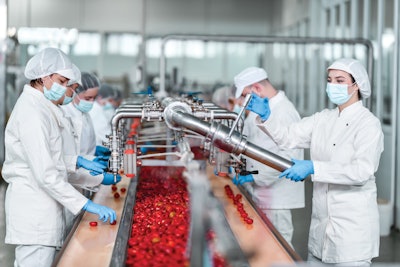
Record inflation and supply chain chaos defined 2022 for food processors and the overall food and beverage industry. While inflation isn’t as high as last year, it’s still lingering, most notably at the grocery store and in foodservice, where year-over-year inflation was 4.9% in July, according to the U.S. Department of Agriculture (USDA) Consumer Price Index.
Ingredient and material availability for manufacturers remains inconsistent too, but processors have had a year to develop alternative supplier contacts and contingency plans when their primary sources can’t deliver, softening supply disruption a bit better than last year.
When it comes to labor and all its connected facets—an ever-dwindling pool of talent, unpredictable turnover rates, inexperienced staff, and more—not much has improved from last year despite a robust job market in manufacturing. Processors are more frequently turning to automation to help ease labor struggles, but the technology hasn’t arrived yet for a manufacturer to become fully automated overnight, no matter what a company’s capex budget is.
Staff shortages and inexperienced labor might also have its fingerprints on a number of troubling elements in the food industry, most notably, several high-profile food recalls over the past year. Consumers experience the front-facing aspect of recalls, but on the manufacturing side, some of these recalls could be rooted in an unstable processing workforce, where experienced employees who understand the importance of hazard analysis and critical control point (HACCP) rules, inspection, and sanitation may not be as plentiful today, and as a result, staff new to the field could be overlooking key steps that result in products going out the door that should not. The labor gap in food manufacturing could have contributed to some food recalls in 2023, as newer workers with little experience executing crucial food safety protocols might be overlooking key steps before a product leaves a facility.Getty
The labor gap in food manufacturing could have contributed to some food recalls in 2023, as newer workers with little experience executing crucial food safety protocols might be overlooking key steps before a product leaves a facility.Getty
Outside of processing plants, construction firms all over the country are in dire need of labor, while the trucking industry has a huge deficit of drivers. That can all add up to delayed deliveries and stalled projects because there aren’t enough bodies to fill open jobs, especially as older workers continue to retire. Wherever there is a shortage of supplier and logistics staff outside the four walls of a plant, it can impact what happens inside a facility.
Another side effect of workforce availability and a shortage of experience is that some companies—particularly in the difficult-to-staff meat industry—might not have done due diligence in hiring and training themselves, or might have used contract labor services that are not entirely in line with U.S. labor laws. Some of the consequences of those oversights have resulted in even more government and public scrutiny of the food and beverage manufacturing industry.
While these are some of the macro effects of the ongoing labor shortage, staffing is just one element impacting the food and beverage processing industry. Here, we’ll drill down into other key areas, and how they affect operations through to consumers at the end.
 Workforce shortages outside of food facilities in the logistics and trucking industries can contribute to inconsistent ingredient supplies and on-time delivery to meet production schedules. The problem has been exasperated by the war in Ukraine and climate change.Getty
Workforce shortages outside of food facilities in the logistics and trucking industries can contribute to inconsistent ingredient supplies and on-time delivery to meet production schedules. The problem has been exasperated by the war in Ukraine and climate change.Getty
Inflation’s continued impact
Last year at this time, our cover story highlighted inflation, due to double-digit rates not seen since the late 1970s/early 1980s. As mentioned earlier, consumers in 2023 are dealing with lower inflation at 4.9%, and the good news is the USDA predicts it to fall further in 2024 to around 2.8%. In the meantime, food manufacturers are still dealing with price spikes and unpredictability for ingredients in the global supply chain, due in part to the war in Ukraine and climate change.
 Inflation for food and beverage at grocery stores and in foodservice combined was at 4.9% as of July this year. The USDA Consumer Price Index is forecasting some relief for 2024, with inflation expected around 2.8%.Getty
Inflation for food and beverage at grocery stores and in foodservice combined was at 4.9% as of July this year. The USDA Consumer Price Index is forecasting some relief for 2024, with inflation expected around 2.8%.Getty
An example of new equipment created to maximize savings overlooked on a production line is an adhesive melter I saw at PACK EXPO Las Vegas, used to glue cases of yogurt or other items before being shipped. In the past, an operator might not have kept tabs on how much adhesive they were using, or how much of it got overcooked and thrown out over the course of a year. However, through today’s cost-control lens, even adhesive is a budgetary item to scrutinize, so the new machine keeps track of the amount of glue used down to the gram, and only works on-demand, saving materials and energy. General inflation for proteins and commodities remain elevated in 2023, while pork, poultry, seafood and eggs are seeing a drop in prices.
General inflation for proteins and commodities remain elevated in 2023, while pork, poultry, seafood and eggs are seeing a drop in prices.
One area that was booming during the pandemic and had a long tail of success afterwards is food and beverage e-commerce. However, as consumers seek bargains and reduce their spending on services this year, e-commerce grocery sales are down 7%, according to Brick Meets Click, from $7.8 billion to $7.2 billion year-over-year (YOY). “July’s [YOY] results reflect the growing financial challenges many consumers are facing today,” says David Bishop, partner at Brick Meets Click.
Another impact from inflation this year is the rapid rise of organized theft across all retail venues, including grocery stores, far beyond anything that was defined as shoplifting in recent years. The National Retail Federation’s annual Retail Security Survey shows $112 billion in losses due to theft in fiscal year 2022, up from $93.9 billion in 2021. Those numbers will likely be higher for fiscal year 2023.
Consequently, grocery stores have started locking up high-target items like ice cream and detergent behind glass cases, opening them only upon customer request. Circling back to this story’s labor theme, high-volume theft means stores not only need additional employees to oversee/open those glass cases, but also must hire extra security to protect the building and its assets. Inflation might be the excuse for retail theft, but the irony is inventory loss will be passed on to shoppers, keeping those prices high even when inflation subsides.
Plant-based food sales drop
Along with e-commerce grocery sales, another area hit by less consumer spending is the plant-based meat segment, which hasn’t reached price parity with traditional meat. As a result, consumers are currently bypassing the higher prices of plant-based meat. Some grocery stores have reacted to their slow-moving inventory by offering buy-one-get-one-free on plant-based meat products, which would have been unheard of in recent years.
 The past two years have seen a drop in volume sales of refrigerated alternative meat products.
The past two years have seen a drop in volume sales of refrigerated alternative meat products.
One person I spoke to recently in the alternative meat industry mentioned off the record that if they received government subsidies like the traditional meat sector, plant-based meats would be able to reach price parity sooner and sales would be steadier, and that it’s not entirely true that consumers are suddenly uninterested in alternative meat as a food source.
Cultivated meat gains approval
California-based cultivated meat brands Upside Foods and Good Meat were granted the final step of USDA approval in June to sell their chicken products commercially in restaurants and retail, and are the first two in the U.S. with that regulatory clearance. The companies had already received approval from the Food and Drug Administration (FDA), as both USDA and FDA approval are needed in the U.S. to sell cultivated meat. Good Meat previously received approval to sell its chicken in Singapore in 2020, the only other country until now to do so.
While the expense of producing cultivated meat currently keeps it from reaching price parity with meat harvested from live animals—particularly the cost and availability of media to feed animal cells while they grow in tanks—two high-profile restaurateurs have partnered with the companies to sell cultivated chicken on their menus. Chef Dominique Crenn will serve Upside’s chicken at her Bar Crenn in San Francisco, and Chef José Andrés will serve Good Meat’s chicken at his China Chilcano restaurant in Washington, D.C.
 | See the technology poised to mitigate the industry-wide CO2 shortage. |
Generally speaking, cultivated meat is grown from primary animal cells in cultivators similar to fermentation tanks for breweries, with some companies using edible scaffolding made of substances like soy or algae, for cells to latch onto and grow into an undefined piece of meat. Because cultivated meat doesn’t grow into specific animal parts, like chicken legs or thighs, for example, the finished mass of meat is formed later into whatever the company wants to sell, like nuggets, tenders, or even whole-muscle slabs.
Watch for more USDA/FDA approval in this space over the next year, particularly in the cultivated seafood segment.
Investment in emerging brands wanes
Plant-based brand Tattooed Chef, which started in 2017 and had reached wide distribution across grocery and wholesale outlets, including Costco, filed for bankruptcy this year as sales of plant-based foods dropped, cost of materials rose, and investors pulled away from funding the company. Tattooed Chef is an example of a newer brand—plant-based or otherwise—that relies on investors to get through financial rough patches like 2023, and this year, investment across the industry in startup and emerging brands has fallen.
At the recent Global Midwest Alliance conference in Chicago, I spoke to Shayna Harris, co-founder and managing partner at Supply Change Capital, about the market conditions for startups and emerging CPG brands, how she approaches this segment of the industry as an investor, and also how she knows when it’s time to stop funding a company. High prices have hit the still-nascent plant-based foods industry in 2023, as consumers shopped for bargains instead. This has had a ripple effect on the investment community for startups and emerging brands, as funding for those companies has waned.Getty
High prices have hit the still-nascent plant-based foods industry in 2023, as consumers shopped for bargains instead. This has had a ripple effect on the investment community for startups and emerging brands, as funding for those companies has waned.Getty
“We do initial checks at pre-seed and seed stage, and then in select instances, we’ll follow with capital,” she explains. “We’re not set up to write the first check all the way to the last check as a $40 million fund. So, we’ve got a diversified portfolio strategy, and with each check, we’re evaluating as if it was a new investment opportunity. Initially, that’s the fear to make an investment today vs. making a new investment in a totally fresh company with a different business plan. Obviously, the comparative set shifts year to year based on what companies you’re evaluating, market dynamics, and pricing for early-stage companies. We’re evaluating each time and it’s delicate and challenging, because when you’re investing early stage in food and food technology, what you need is a combination of equity and debt. And that can be difficult unless you already have equipment to finance or other assets that you can either finance or borrow against.”
Harris mentioned one company in her portfolio that didn’t succeed very early on. “It was really frustrating,” she says. “It was at a time where they were about to close their Series A funding and then the market turned. So, had that been a different market environment or a year or two earlier, we think the outcome would have been different.”
Environmental goals
While global brands like PepsiCo, General Mills, Cargill, Kraft Heinz, JBS and others publicized their corporate sustainability initiatives this year in areas like recycling, the circular economy, energy-efficient factories, methane gas conversion, reducing beef emissions, phasing out plastic use, moving to paperboard packaging, and more, 2023 has been the year where some sustainability goals set years prior and earmarked for completion timelines like 2025 may have been underestimated, and might serve as a lesson for current and future sustainability goal setting.
At the interpack show earlier this year in Düsseldorf, Germany, I watched a panel of global sustainability experts unanimously agree that global recycling initiatives for CPG packaging were nowhere close to meeting a previously set 2025 goal, and doubted those goals would be accomplished on time. Those on the panel also mentioned that a combination of wildly different rules and guidelines from state to state in the U.S., coupled with general consumer indifference to do the work it takes to recycle properly (like separating materials into different bins), and the overall lack of a proven business model to invest in recycling infrastructure and make it profitable, means it’s unlikely some near-term recycling goals will be met.
 | See two future trends to watch for food facility drains. |
The panel concluded that broadly defined sustainability goals—which look good on paper—are not as effective as working within a “silo of sustainability” with a clear focus on one objective to help achieve those ambitious goals on time.
From a consumer standpoint, consulting firm Kearney reported the emerging awareness of “climavorism,” which can be defined as shoppers making conscious choices about what food and beverage they buy based on climate impacts in producing/distributing those products, with the overall intent of benefitting the planet through their purchases. Kearney mentioned that inflation has slowed down the adoption of climavorism this year, but predicts it will gain momentum again when prices return to normal.
Plant construction pipeline
Several food and beverage plants are slated to begin construction or expansion this year, including:
· Upside Foods is building a $140 million, 187,000-sq-ft cultivated meat plant in Glenview, Ill. It’s Upside’s first commercial facility since gaining USDA approval to sell cultivated meat in the U.S. No timetable has been announced for construction.
· JBS is building its first commercial-scale cultivated meat plant in San Sebastian, Spain, for $41 million. The plant—expected to open in 2024—will have the capability of producing 1,000 metric tons of cultivated meat per year, with room to expand to 4,000 metric tons.
· A subsidiary of Ferrero Group (Wells Enterprises) plans to double the size of its Dunkirk, N.Y., manufacturing facility, where frozen treats like Blue Bunny ice cream and Bomb Pop are made. The expansion is scheduled to be finished in 2025.
· Anheuser-Busch is investing $22.5 million into its Houston brewery, upgrading the facility’s internal systems to improve energy efficiency and workplace safety. Work on a new cooling system as part of the project is expected to be completed by the end of 2023.
· Heineken Mexico is building a $460 million greenfield brewery in Yucatán, with construction scheduled to be finished by 2026.
· Campbell Soup is investing $160 million at its Richmond, Utah, plant to expand production of Goldfish snack crackers by 5 million per hour and double the bakery’s output by 50%. The project is expected to be completed in 2024.
 The USDA granted approval this year allowing two U.S. cultivated meat companies to sell their products to the public. This regulatory breakthrough means other cultivated protein products like seafood could also gain approval in the near future.Getty
The USDA granted approval this year allowing two U.S. cultivated meat companies to sell their products to the public. This regulatory breakthrough means other cultivated protein products like seafood could also gain approval in the near future.Getty
Mergers and acquisitions
Among the biggest announcements at the corporate level of food and beverage manufacturing was Kellogg splitting its business into two separate entities: a snacking brand called Kellanova, and a cereal brand called WK Kellogg Co.
Kellogg was a rare example of a company expanding internally, while much of the industry was growing through mergers and acquisitions. Here are some of the most prominent M&As in 2023 so far:
· Campbell Soup purchased Sovos Brands, maker of Rao’s pasta sauces, for $2.7 billion.
· Anheuser-Busch sold eight beer and beverage brands to cannabis company Tilray Brands for an undisclosed amount. The beverage brands acquired by Tilray include Shock Top, Breckenridge Brewery, and Redhook Brewery.
· Keurig Dr. Pepper paid $300 million to acquire 33% of La Colombe Coffee Roasters.
· Molson Coors acquired Blue Run Spirits for an undisclosed sum.
· In the grocery industry, Aldi acquired 400 Winn-Dixie and Harveys Supermarket locations in the southeast U.S. for an undisclosed amount.
· In foodservice, Subway was sold to Roark Capital for just over $9 billion.
· Marie’s and Dean’s dips—both part of Ventura Foods—were sold to Brynwood Partners for an undisclosed price. The brands will become part of Brynwood’s West Madison Foods.
· Plant-based company Livekindly Collective acquired plant-based brand Alpha Foods. Financial terms were not announced.
· Lactalis Canada bought dessert brand Marie Morin Canada. Financial terms were not disclosed.



















